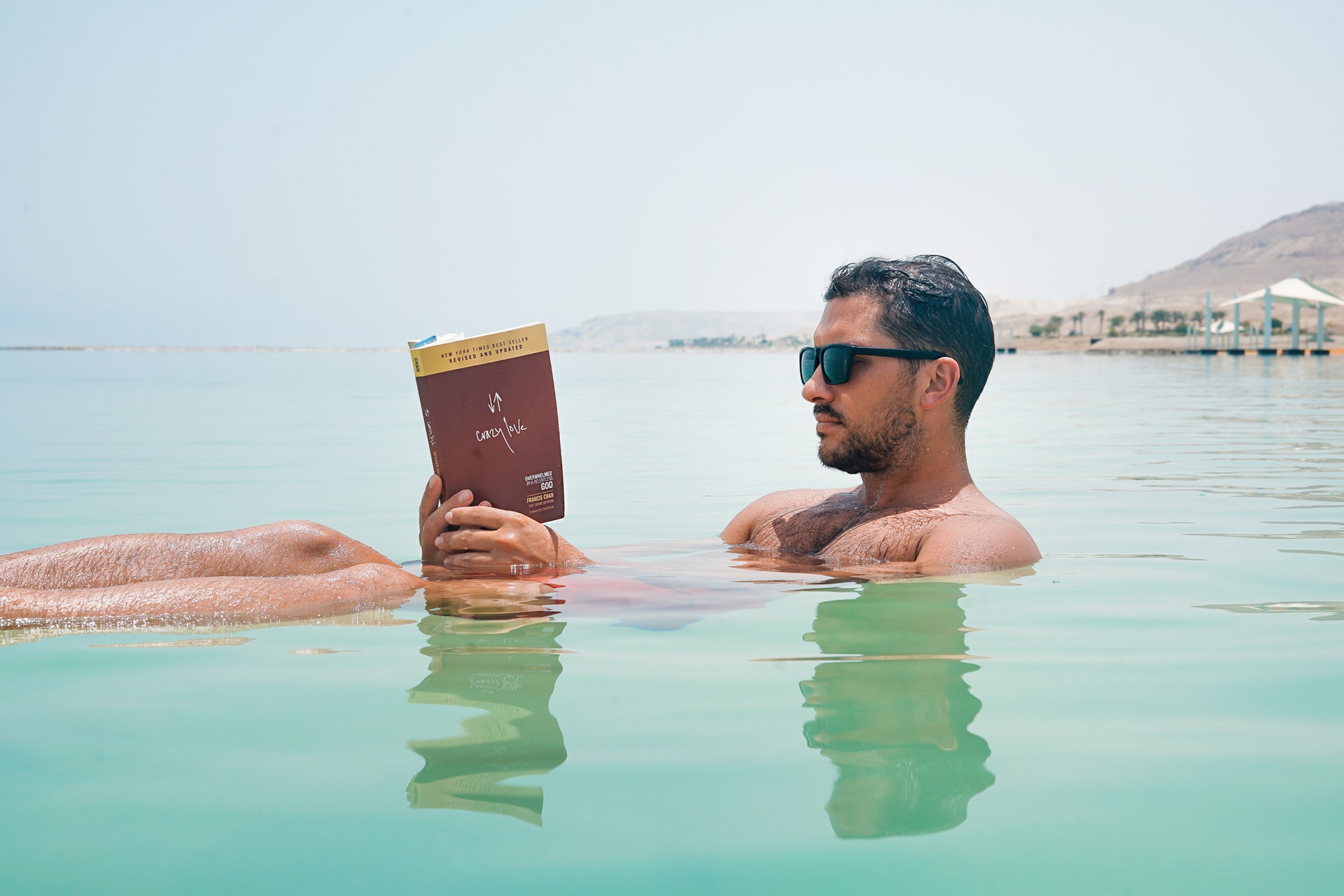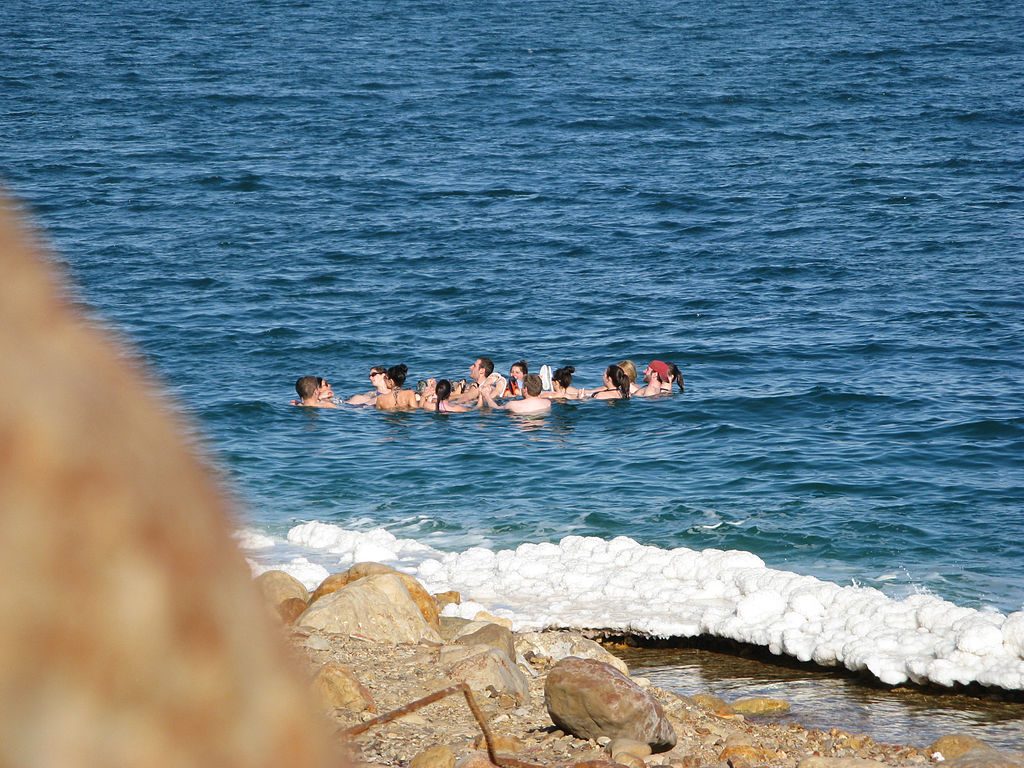The Dead Sea is known as Yam HaMelah (The Salt Sea) in Hebrew. It derives its name from the waters’ high salinity level, which creates an environment that’s far too harsh for harboring plants and marine animals.
Contrary to what its name suggests, the Dead Sea is far from dead. It cradles a rich natural history and boasts of a majestic, natural beauty. The cobalt and turquoise waters of the Dead Sea are oily in consistency with minerals and heavy with salt. In fact, they contain 21 different types of minerals, including calcium, sulfate, and magnesium. Some of the minerals in the Dead Sea (12, to be exact) you can’t find in any other bodies of water.
If you are visiting this natural marvel, read through our comprehensive Dead Sea travel guide to enjoy a smooth and worry-free vacation.
Where is the Dead Sea Located?
At more than 400 meters below sea level, the Dead Sea is the lowest place on earth. It is a land-locked lake (yes, it’s a lake!) in the Middle East, flanked by the Judean Mountains and the Moab mountains. It is part of the Syrian – East Africa Rift Valley, bordering Jordan to the West and Palestine and Israel to the East.
Its sole source, the Jordan River, is not connected to the ocean. It is also without any outlets, and the only way water escapes from the lake is through evaporation. It loses about 7 million tons of water daily, which explains the high concentrations of salt.
Facts About the Dead Sea
- The Dead Sea is not the saltiest lake. Dead Sea ranks among hypersaline lakes with more than 30% salinity, but it’s not the saltiest. Don Juan Pond in Antarctica tops the list, with more than 40% salinity.
- It is much saltier than any regular ocean. Average seawater contains about 3% of salt, which makes the Dead Sea about 8.6 times saltier than an average ocean.
- Its salt concentration can make you buoyant. As water evaporates, massive amounts of salt are left behind. The salt is so dense people can float on top of them.
- It may have healing powers. Some doctors even prescribe a visit to the Dead Sea to help patients with respiratory issues, joint problems, and skin conditions such as acne, psoriasis, and even cellulite.
- Dead Sea mud works wonders for the skin. The deposits of black mud that come from the seabed is beneficial to your skin as it contains high levels of calcium, magnesium, sodium, and potassium.
- The Dead Sea contains some life – microbial life, to be precise. While the Dead Sea’s salt content is far too high for any plants or animals to survive, scientists say microbial life exists at the bottom of its waters.
- It’s always sunny at the Dead Sea, with 330 days of sunshine and less than two inches of rain in a year.
- Despite the constant sun, the UVB rays are weaker in the region, so you can worry less about sunburn if you accidentally forget to put sunscreen.
How to Visit the Dead Sea
Dead Sea tourism contributed largely to the record-breaking 3.7 million Israel visitors last year.
Depending on where you’re coming from, you can reach the Dead Sea via a private car or a bus. Traveling with a group or with a private guide is also a convenient option. Here are ways to get to the Dead Sea from Tel Aviv, Jerusalem, and Masada.
Tel Aviv to the Dead Sea
By Car
If you are driving, traveling from Tel-Aviv to the Dead Sea may take anywhere from a little over two hours to more than three hours, depending on the day and the route. You may take either the Jerusalem route or the Be’erSheva and Arad routes.
By Train
Note that there is no direct train line between Tel-Aviv and the Dead Sea. If you wish to take the train, you may take the Be’erSheva route by train and then take the bus to the Dead Sea.
By Bus
Take one of the scheduled bus trips to the Dead Sea at the Tel-Aviv New Central Bus Station. You may also catch a bus at the Tel-Aviv Merkaz Railway Station, also known as the Arlozorov Terminal. Tip: there are two bus terminals at the Tel-Aviv Merkaz Railway Station. When facing the railway station entrance, you want the one on your left.
Jerusalem to Dead Sea
By Car
Your Dead Sea travel experience becomes easier when you travel to Jerusalem by car. You also get the freedom to explore other stunning sites that you will encounter along your journey. Soon after you leave Jerusalem, for example, you enter the Arava Valley, where you can see magnificent views of Qumran and Jericho. Less than 30 minutes into your drive, you will arrive at the sea-level point and have your photo taken there (there is a sign that will tell you you’ve reached the sea level).
When you arrive at the Dead Sea, the first thing you’ll notice are the Bedouin tents that sell pottery and various kinds of souvenirs. From that point, drive straight ahead. As you make a right turn toward the Dead Sea, you will see one of the few gas stations in the region. Take this chance to fill up your tank, stock up on snacks, and stretch your legs a little.
As you drive down south, you’ll start seeing the various Dead Sea Beaches, followed by EinGedi, Masada, and finally, EinBokek. If you choose to make the most out of your Dead Sea trip and drive further, you will arrive at Eilat in a few hours.
Note that the downhill roads can get steep and winding, so be sure to drive slowly and carefully.
By Taxicabs
You may have a private taxicab take you to the Dead Sea (or Masada) from Jerusalem. The trip may cost around 350 ILS.
By Bus
Take the egged Bus 486 from the Jerusalem Central Bus Station (go to platform 5) straight to the Dead Sea, as well as EinGedi and Masada. One hour away from Jerusalem is a public beach at the Dead Sea that is accessible to all. Do note that buses are unavailable on Shabbat which runs from Friday afternoons through Saturday evenings.
Masada and the Dead Sea
By Car
If you are staying for an extended period, renting a car is a practical option. It lets you enjoy more tourist sites without being pressed for time and worrying about getting from one point to another. You may rent a car in EinBokek at the Dead Sea, or from the Ben Gurion Airport, Jerusalem, or Tel Aviv.
By Bus
A shuttle bus runs regularly throughout the week. Designed with tourists in mind, it stops at one of the beaches and then returns to Jerusalem in the afternoon.
Top Tips When Visiting the Dead Sea
- Wear tough and high-quality flip-flops to make the most of your Dead Sea vacation. Protect your feet from the white-hot sand and the occasional sharp stones. Thick slippers give you a better grip, enabling you to navigate the salt deposits more easily.
- Be prepared for some pain. The salty water will make even a tiny scratch sting. Save the shaving for after your Dead Sea trip to prevent nicks and scratches.
- Bring a huge bottle of fresh water. The Dead Sea’s dry heat can go up to 47°C, which can be dehydrating.
- Keep your head above water. Healthy skin can fare well in the Dead Sea’s salty waters. Individuals who swallow or inhale even just a bit of water, though, may require medical attention, especially those with a heart condition. Try to keep the water away from your eyes to avoid ferocious stinging.
- Call 101. To receive help in medical emergencies, wherever you are in Israel, call 101.
If you are thinking of visiting the Dead Sea to see and experience its wonders, there’s no better time to do it than now. Its landlocked nature causes that water to evaporate at a rate of one metre every year, and experts predict that the Dead Sea could be reduced to a puddle by the year 2050. Immerse yourself in the Dead Sea’s wondrous waters, its rich history, and its serene, calming horizon before it’s too late.


